Gordon Shephard – the man who never was?
Dr Trevor Adams
Introduction
My interest in Gordon Shephard stems largely from the fact that his Irish adventures are ignored by the British records1,2, and that he and his WWI adventures are ignored by the Irish, certainly those of a republican leaning – hence the title of this article, with apologies to Euan Montague for stealing the title of his WWII true story. But here is another true story which, if written as fiction, would be dismissed as being too far-fetched.
The aim of this article is to try to understand Shephard and, as it were, to get inside his head. To do that, we have to look at his pre-WWI adventures, especially his sailing and his learning to fly. The relationship with the Childers is important. Erskine Childers’ only novel The Riddle of the Sands plays a role in Shephard’s life, as indeed it also does, I would suggest, in the whole episode of the 1914 gun-running on Childers’ yacht Asgard.
What sources of information about Gordon Shephard are available? Well, he was killed during WWI in a flying accident on 19th January 1918 at Auchel airfield. At the time of his death he was a Brigadier-General in the RFC and was aged 32. He was the most senior RFC or RAF officer to be killed in WWI. People who are killed in a war do not leave behind memoires, though in Shephard’s case there is at least a book composed of his letters over the years and his sailing log, edited by old Etonian – Shane Leslie of Castle Leslie in County Monaghan3. The Leslie family still own Castle Leslie today. The book was privately published by Shephard’s parents in 1924 and is hard to find. However, indirect sources of information on him include books on Erskine Childers, the account of the Asgard voyage by Mary Ellen Spring-Rice in the National Library of Ireland, Sholto Douglas’ memoires of WWI, and the archives of the RAF. It is a question of putting together a patchwork of information on him. So, let’s start at the beginning.
Gordon Shephard’s background
Gordon Shephard was a child of the British establishment. He was born at Madras in India on 9th July 1885. “Gordon” was used as a Christian name by upper crust English of the era to commemorate General Gordon, who died in an ill-fated invasion of the Sudan in 1885. Shephard’s father was an advocate-general in the Raj, the British colonial regime, who became a judge shortly after his son’s birth. He was awarded a knighthood later in his career. Gordon Shephard and his brother were left in England at an early age, to be schooled, whilst their parents returned to India. Gordon and his brother Jack were sent to preparatory schools and then to Eton. It was at school that Gordon developed his talent for sailing. To quote the Leslie memoires: “Eton does not dispose boys to hard work so much as to a sense of the world”3. Shane Leslie was speaking from first-hand experience, as he too was an Etonian. Erskine Childers was not at Eton – he had been at Haileybury, which is also a prestigious English public school.
Gordon Shephard left Eton in 1902 and went to Sandhurst and then to the Military College at Camberley. He was commissioned in January 1905 and joined the 7th Royal Fusiliers at Parkhurst on the Isle of Wight. There was little happening there, and the battalion rented the shooting at Parkhurst Forest. Nobody managed to shoot anything, as there did not seem to be anything there to shoot, except Gordon Shephard who did manage to shoot himself, and lost two toes as a result. This made severe marching impracticable for him for the rest of his days. One of his colleagues from those days, Robert Henry Pipon, describes Shephard as: “From first to last he was certainly the most unmilitary soldier I have ever known”5. Incidentally, in 1914 the then Lt Colonel Pipon was asked by Erskine Childers to take part in the Asgard voyage, which he refused to do, as he considered Childers to be a crackpot and “something always happens to crackpots”6.
Sailing, sailing and more sailing
In their years on the Isle of Wight, Pipon and Shephard bought an old yacht, Laural, and sailed her as far as across the English Channel. She was destroyed in an accidental fire at a boatyard in 1908. In 1910, he acquired the Sorata, a 12 ton yawl (which is a type of two-masted yacht), on which he undertook extensive cruises, notably to the Friesian Islands and the Baltic. Part of the reason for his choice of destination was that he met Erskine Childers for the first time in August 1909. That date is important when we later come to look at Childers book The Riddle of the Sands.
But why would anyone want to go to the Friesian Islands or the Baltic? The Baltic has archipelagos, notably the approach to Stockholm which has more than 20,000 islands, and the area between Turku in Finland and the Aland islands. These provide a maze of sheltered waters which must be heaven for a yachtsman. The Friesian islands lie off the Dutch and German coasts which are low lying, with a myriad of channels through the mudflats. At low tide, you can walk for miles. Of course, the area on the German coast was of strategic interest, with the navy bases at Wilhelmshaven and Bremerhaven, and the airship base near Cuxhaven. A knowledge of the channels through the mudflats would be important for any attack on these bases.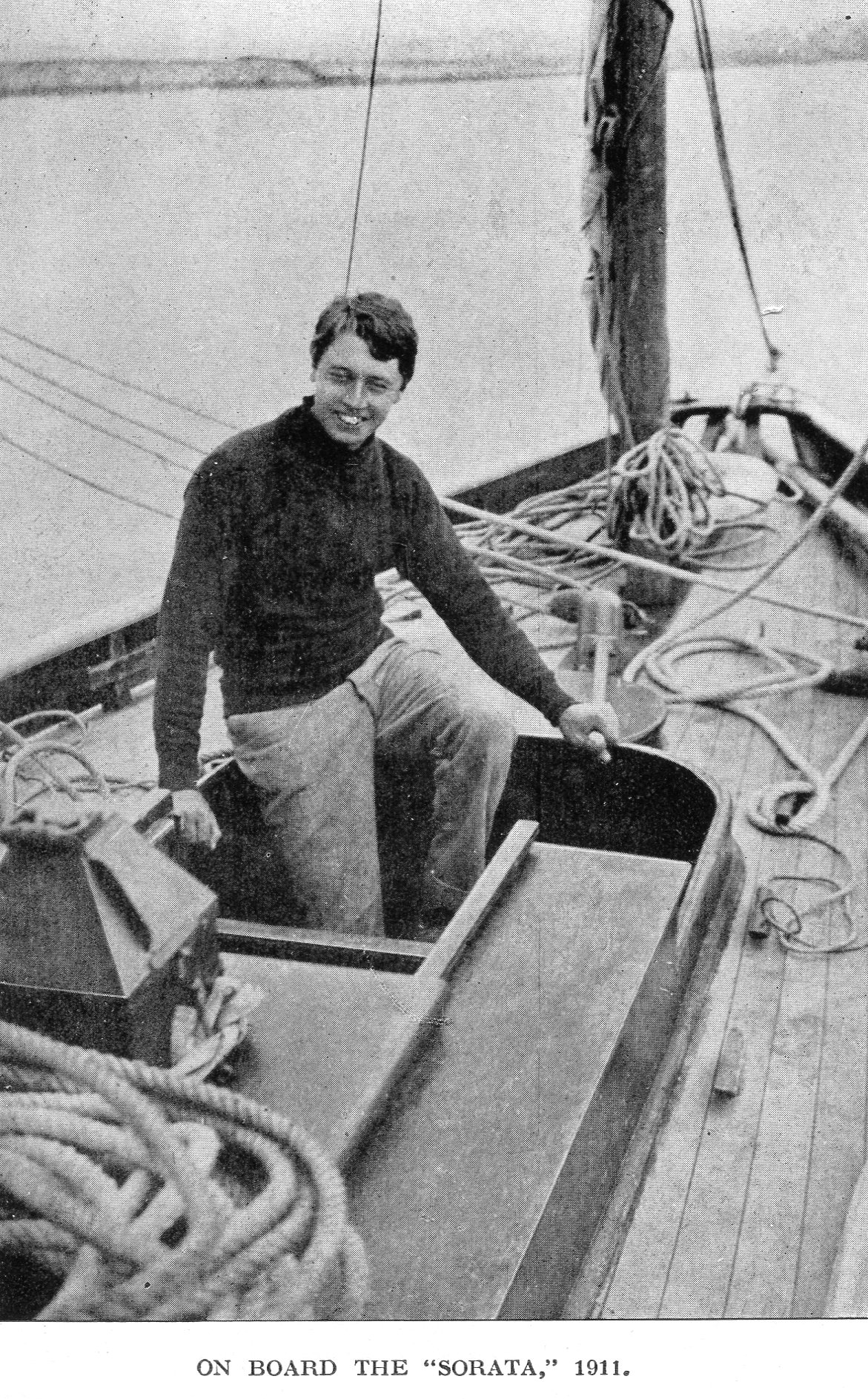
In 1910, Shephard took the Sorata on a long cruise to the Baltic and the Friesian Islands. He and his companions set off with 10 weeks of supplies, which were needed as they chalked up 3154 miles. They sailed through the Stockholm islands “[I] had never expected anything so beautiful”7, up the Gulf of Bothnia (the sea between Sweden and Finland) “the country is flat, bleak and dismal”8, avoiding sea ice, in May, though and went as far as St Petersburg. To do that, they must have sailed through the Russian naval base at Kronstadt9,10. (Photo above: Gordon Shephard aboard the Sorata.)
In 1911, he undertook a cruise to the Friesian Islands and to the estuary of the River Ems, which was, and is, the border between the Netherlands and Germany. Here, he and his friend made the unfortunate decision to go on a day trip to the German town of Emden. Shephard took some snapshots of the harbour there, and ended up being arrested and held for some days as a possible spy12. In the end, Shephard and his friend were let go by the German authorities and they continued their cruise. However, this was to be the last of visits to the Friesian Islands as his leave for such adventures was stopped for a long period by the War Office.
The approach to Stockholm, through the archipelago
The response of the War Office and Admiralty to his sailing adventures on the German North Sea coast varied from apathy to hostility. The War Office even stated that they had “no interest” in German coastal defences!
In 1913, after a summer cruise with the Childers, he borrowed the Asgard and undertook an autumn cruise from Christiana (Oslo today) to the west coast of Norway, across the North Sea, thence to the Shetlands, the Orkneys, the Western Isles, Ardglass, Holyhead, and home to Conway. This adventure was awarded the Royal Cruising Club Challenge Cup for that year. The magazine Yachting Monthly commented: “It was a truly remarkable performance but…only men of intrepid courage would have attempted it.” Crossing the North Sea in a yacht is adventurous at the best of times, let alone with the risk of autumn storms.
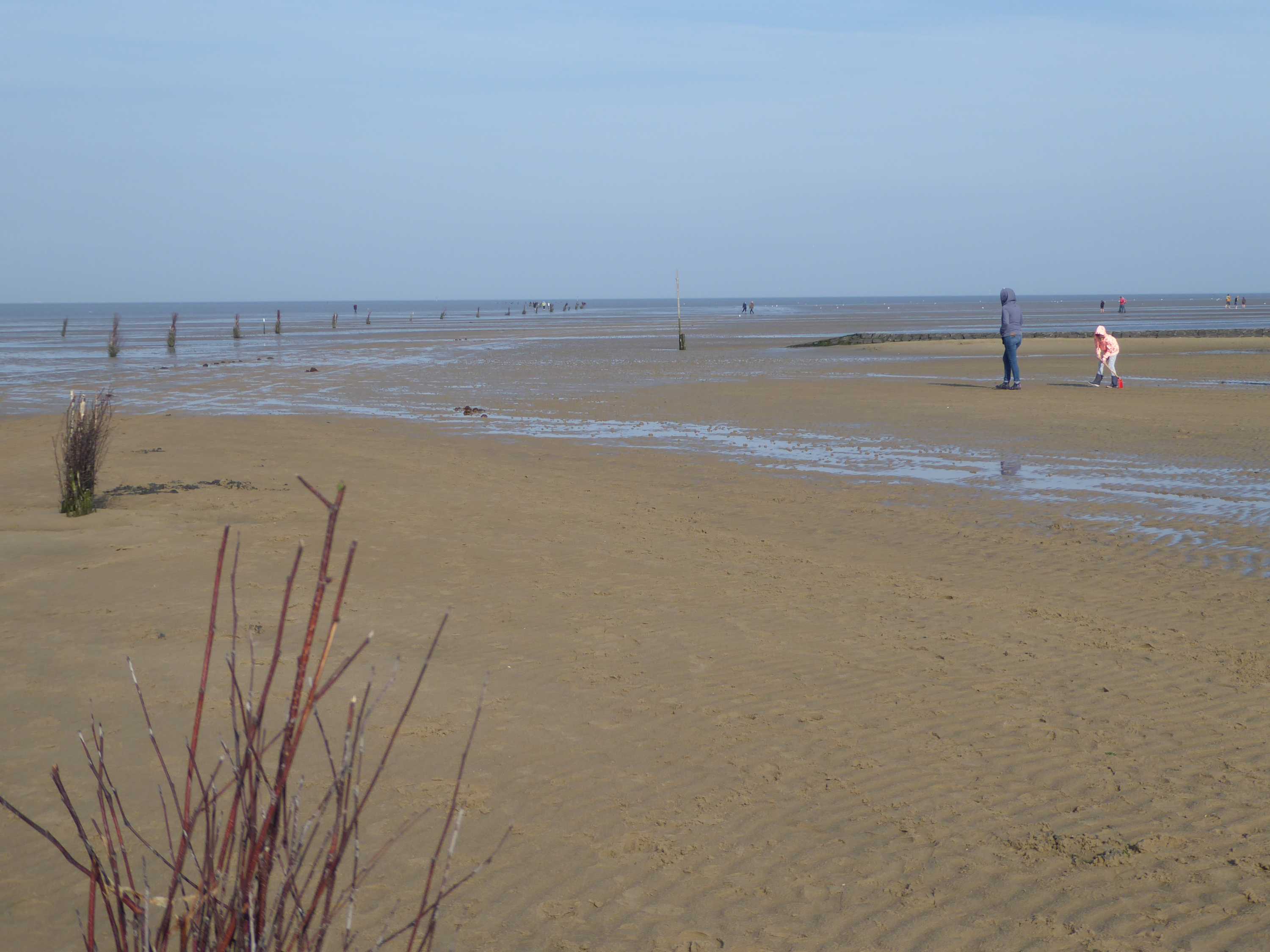 The bleak German coast near the Friesian islands
The bleak German coast near the Friesian islands
Erskine Childers, the Riddle of the Sands, and Charles Carruthers
Childers wrote his one and only novel, The Riddle of the Sands about a sailing and spying adventure set round the Friesian Islands. It was published in 1903, and has never been out of print since then. Gordon Shephard was widely assumed by his comrades in WWI to be the person upon whom the key character in the book, Charles Carruthers, was based. Well, one can see the logic, but it is total nonsense. In 1903, Shephard had just left Eton. He and Childers were not to meet for another six years. However, he must have read the book – is there a yachtsman who hasn’t? It may well have played a part in Shephard’s adventures, and indeed was referred to, at length, in the 1910 trial of the two British officers in Germany. Was the plot of this novel the inspiration for the idea of gun-running from Germany to Ireland on a yacht, in 1914?
Childers and Shephard met for the first time in August 1909. Erskine and Molly Childers became great friends with Gordon Shephard and went sailing with him. So, the scene was set for the Asgard gun-running, but before that we need to have a look at his other passion – flying.
Flying
There was an ulterior motive in learning to fly: the Flying Corps was likely to give Shephard the freedom to continue his yachting adventures. He seems to have started around 1910 with flying lessons, and achieved his flying licence in 1912 at the Brooklands flying school. Up until 1916, all RFC pilots had to qualify at a civilian flying school. In 1912, his regiment was based in Dublin but in July he was ordered to join the RFC at Farnborough. The RFC then consisted of 22 aircraft and two airships.
Aircraft of this era could only be flown if there was negligible wind. Up until 1915, they did not have wing flaps but were controlled by flexing the fragile wood and cloth wings. The pilot was very exposed to the weather, flies, birds, and the exhaust from the feeble engine which emitted oil mist from the castor oil used to lubricate engines in the WWI era. Castor oil is a laxative. These aircraft were very hazardous. In a letter of 24th September 1914, Shephard writes: “Things seem to be going quite well now. The casualties of the Flying Corps in war turn out to be about the same as in peace”.
During the army manoeuvres of 1913, Shephard took part, both as a pilot and an observer. His views on the lessons to be learned in terms of effective air observation and co-ordination with the ground forces were largely adopted. These improvements appear mundane in some respects but this was the early days of military use of aircraft, eg having telephones at the airfield so observers did not have to travel to the local HQ, using message bags to be dropped from aircraft, training for observers, separate compasses for observers, and the army ground commander briefing the air crews on what his troops were going to do on the day.
We will look at some of his wartime flying below but first of all, there is the voyage of the Asgard.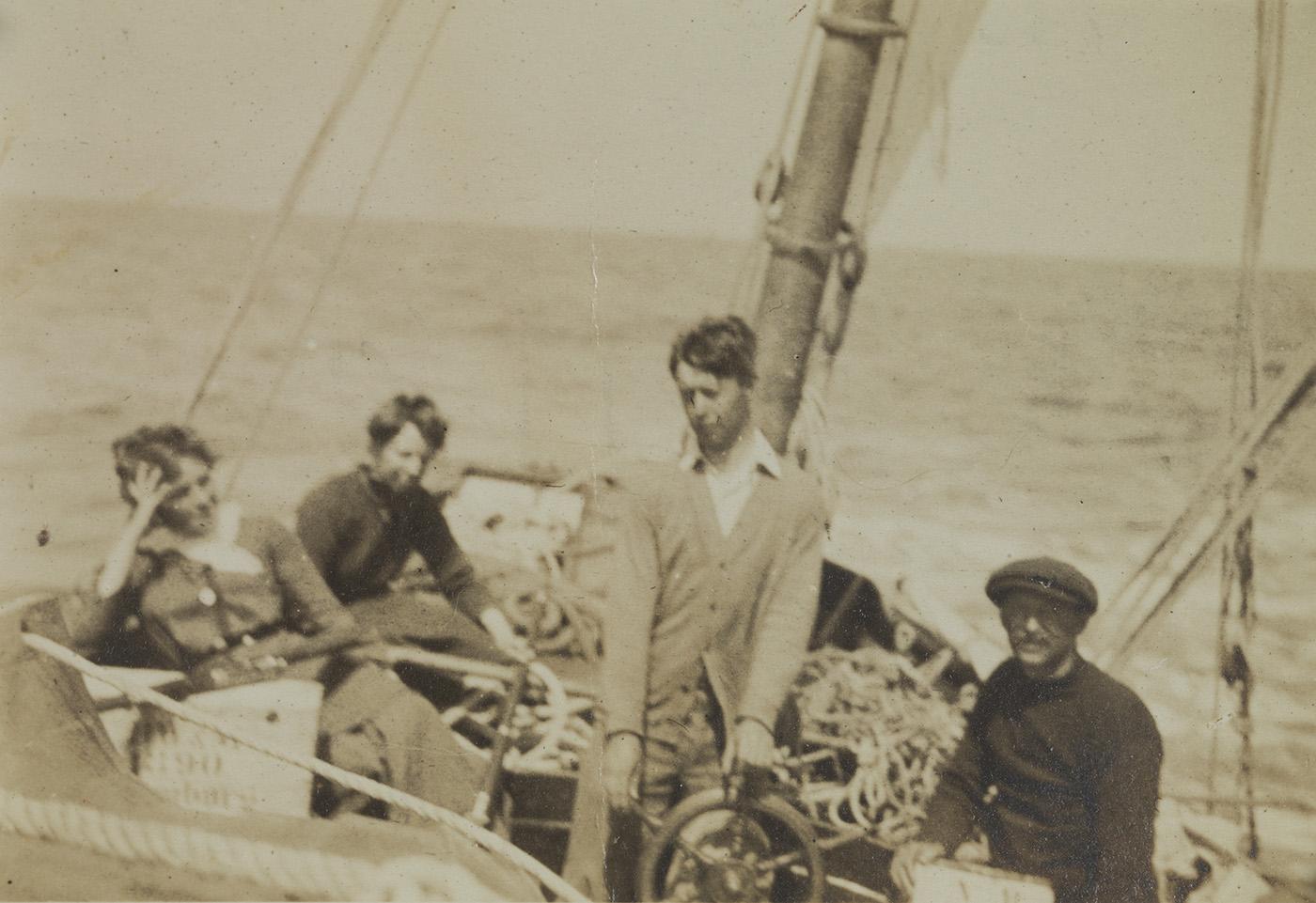
Gun-running
Shephard and his friend Robert Pipon, both serving army officers, were both approached by Erskine Childers to take part in the Asgard voyage. Both were experienced yachtsmen. Pipon refused and Shephard accepted. The voyage started from the Welsh village of Deganwy, on the Conwy estuary, to where the Childers had sailed their yacht from Holyhead. The diary of the event was written by the Honourable Mary Ellen Spring-Rice13. (Photo above: Gordon Shephard at the wheel of the Asgard, courtesy of Trinity College Dublin.)
Shephard, referred to as “Mr Gordon” as some attempt to disguise his identity, met the other participants at Deganwy on Friday 3rd July 1914. They set off immediately and hit stormy weather.
Gordon Shephard was a big fan of golden syrup, and that seemed to be an easy way of getting him up in the morning. He seems to have always been the last person into breakfast. For supper on one day, he cooked a “sweet omelette” which was buttered eggs cooked with his beloved golden syrup.
Shephard and Childers did the steering and navigating. (It is worth noting that yachts like the Asgard would not have had an engine at this stage of her life, which must have made entering and leaving port very difficult for yachtsmen of the era.) Gordon Shephard found his bunk too stuffy, so took to sleeping in the passageway, where everyone had to step over him. On one occasion on the return journey, he spilled coffee over some of the guns and was chastised by Molly Childers for “ruining” the guns. In order to avoid him appearing at Howth with the guns, the aim was to put him ashore on the return journey at St Ives or Milford, and in the end the yacht put into Milford. He travelled over to Howth via Holyhead, so was present there when the rifles landed anyway on 26th July 1914. He and Mary Ellen Spring-Rice lunched with friends, Dermot Coffey and his wife, at Howth and had tea at the Arts Club in Dublin later that day.
Shephard’s letter to his father dated 1st August 1914 states: “The Howth business is rather losing its importance now, but it should stimulate the Nationalists. I will give you a proper description when I see you.” Presumably, “stimulating” the Nationalists to act against the army in which he was a serving captain!
War service
The aspect of RFC activities in WWI which springs to mind is that of aerial combat – Ball, McCudden, Mannock and others. However, the main tasks of the RFC were observation, both in terms of troop movements and construction of new enemy defences, and also for artillery spotting. Later, aerial photography became more important, and with better aircraft, bombing attained some sort of feasibility.
Shephard was involved in the early stages of observation. The report from his observer, Lt Bonham-Carter from 22nd August 1914 is below, at the end of this article. He and Shephard had seen large scale German troop movements and also had had information from the French army to similar effect. (Shephard spoke French and German). Unfortunately, the command of the BEF did not pay enough attention to such reports, and were surprised by the German attack on Mons at 06.00 on 23rd August. 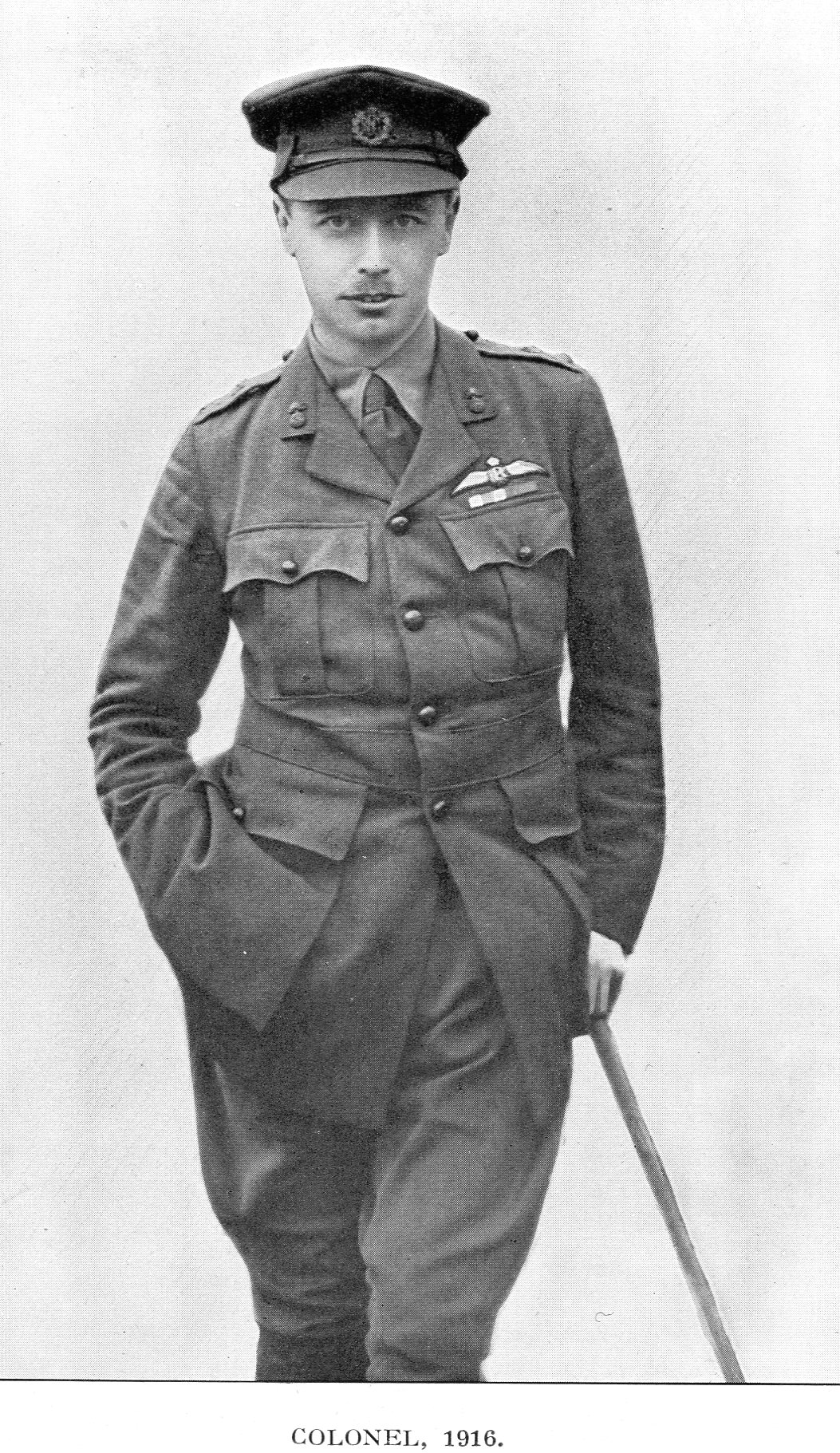
He continued his reconnaissance work during the retreat to the Marne and the subsequent advance. On one occasion, his plane was so damaged by ground fire that it had to be abandoned. On another, he found a bullet hole in his breeches which did not concern him in the slightest. He was awarded the Chevalier of the Legion of Honour and awarded the Military Cross “for services in connection with operations in the field”, and was mentioned in despatches six times.
He returned to the UK on 25th November 1914 and was promoted to Major on being given command of No 1 Reserve Aeroplane Squadron. On 4th March 1915, he was on the Western Front. His squadron was involved at Neuve Chappelle doing reconnaissance, photography and artillery spotting. There was some bombing of railway facilities. In March 1915, he wrote “…our work is considerably altered. It is nearly all with artillery”14. Other extracts from his letters of this time are15:
“The attitude of the Staff towards aeroplanes is amusing. At the beginning they did not believe in them. Now they expect us to end the war!” 10th April 1915.
“I hear the Germans are near Riga. Unfortunately, I am a stockholder in municipal stock of that town.” 7th May 1915.
“People seem to make a great fuss of the Lusitania. Her fate can only make the Americans more friendly. Otherwise, the course of the war will not be changed.” 15th May 1915.
“I wonder K [Kitchener] does not resign. The job is clearly beyond him. The War Office is filled with retired officers who cannot grapple with the situation.” 27th June 1915.
“I see they were not slow to decorate the naval officer who attacked the Zeppelin. Everybody in England seems to think that Zeppelin bombs are directed at them personally”. 13th June 1915.
“I do not see eye to eye with you in the matter of conscription, till there is some assurance that the lives of the conscripted will not be thrown away on unprofitable ventures in different parts of the globe according to the ever-changing policy of our leaders.” 28th October 1915.
“In my opinion, Grey [Sir Edward Grey, the Foreign Secretary] is perfectly hopeless. He is probably sincere and honest with the exception of promises to Serbia, but people seem to take him in right and left. If it were not for Carson’s political views, I should become a Carsonite after his fine speech.” 12th November 1915.
On 10th December 1915, Shephard was promoted to Lieutenant Colonel in charge of the 8th Wing. He commanded the 12th (Corps) wing comprising of three squadrons, in March 1916.
“There will be several other cases like the Sheehy-Skeffington one16, in my opinion, before the war is over. I think there have been enough executions now. There can be no reason to prolong the Irish trouble in this way.” 17th May 1916
“In my opinion, Kitchener met his death at a well-chosen moment for himself. I don’t see that they want anybody at the War Office……..I hear that Professor MacNeill was sentenced to penal servitude for life, which seems very severe, though I suppose they will let him out soon”10. 12th June 1916.
“Why cannot they give home rule to Ireland now that the six Ulster counties are excluded? I cannot see on what grounds the Unionist base their objections. I like Mr Redmond’s speech. It is time the Coalition realised that they should at least make a show of keeping to agreements.” 23rd June 1916.
“I have just been reading Casement’s speech, and was specially impressed by the last part of it. If he is hung, it will only make his name remembered in Ireland, whereas now he is not well known in that country”. 1st July 1916.
“But after all, it is not of much significance who runs the government, as the whole policy is evidently dictated by Lord Northcliffe [owner of the Daily Mail and Daily Mirror, who was born in Dublin in 1865].” 12th December 1916.
On 8th February 1917, Shephard was promoted to Brigadier-General on taking over command of I Brigade. This consisted of two Wings totalling seven squadrons.
“I see a number of German yachts are being sold. If I had been at home I might have bought one. I do not hope for much from the Irish Convention, but it was a clever move on Lloyd George’s part to get out of his difficulty.” 25th May 1917.
“It is a very good thing that Erskine Childers has now got the job for which he is most eminently suited, and I imagine the Convention will last for some time…….Mrs Childers says the Sinn Feiners will accept Dominion Home Rule.” 7th July 1917.
Gordon Shephard often flew round the Western Front to visit his squadrons. Such a routine visit took place on 19th January 1918. Shephard flew a Nieuport Scout No B/3610 to the airfield at Auchel to visit the three squadrons based there. His machine went into a nose spin near the airfield and crashed. He died of his injuries.
He was buried at LaPugnoy CWGC cemetery which lies west of Bethune18. His funeral was attended by “some twenty generals and a thousand officers, which was preceded by Canadian pipers and a firing party, and conducted by Fathers Grey and Carden according to the Catholic and Roman Church to which friends had always believed that he belonged.”19
Postscript
In Sholto Douglas’s autobiography “Years of Combat”20, he says of Gordon Shephard:
“There was one other man under whom we came to serve at that time who was also to provide me with a lesson in the matter of leadership. We were in the Frist Brigade of the RFC which was commanded by Gordon Shephard, a Brigadier who, for all his exalted rank, was only about 35 years of age [he was actually 32]…………………….
Although he was not a good pilot, Gordon Shephard’s mind was of a brilliance that would undoubtedly have led to his becoming in time one of the great leaders in the Air Force; but the poor flying of his brought about his death in an accident before the end of the war, and so his name came to play only a minor role in the history of flying.”
Oswald Birley refers in a tribute to Gordon Shephard as being intensely unmilitary21:
“He hated being either called or considered a general. Promotions, decorations, etc, all that was most dear to the average regular officer, left him completely cold. But his mind was never still and I am sure was nearly always working on the one main theme, ie a better combination of all the known modern engines of war.”
Sholto Douglas recalls the modest origins of those who would be some of the big names in the RAF in WWII, including himself who did not obtain his pilot’s licence until June 1915. So, Peter Portal was a ranker in the Royal Engineers, Keith Park was an NCO in the artillery in Gallipoli, Hugh Dowding was a captain in the Royal Garrison Artillery, Hugh Trenchard learned to fly at the age of 41, Arthur Harris was a bugler in the Southern Rhodesia Regiment in German South West Africa, and Arthur Tedder was a colonial civil servant in Fiji22.
So, Gordon Shephard was an experienced pilot at the outbreak of WWI and in 1918 would have outranked the men who became the leaders of the RAF in WWII. What would have been Gordon Shephard’s position in the RAF in WWII? Well, we will never know.
What does one make of Gordon Shephard the man? He was not a man for causes, as was Roger Casement. Rather, he comes across as an amiable adventurer who was game for anything that turned up, be it adventurous sailing, flying rickety aircraft, or being in a world war. There was a German aviator of the era who was the only German PoW to escape from Britain in WWI, Gunther Pluschow, and who after WWI did a lot of aerial exploration in Tiera del Fuego in South America and who died in an air crash there in 1931. I always think that he and Gordon Shephard were two of a kind.
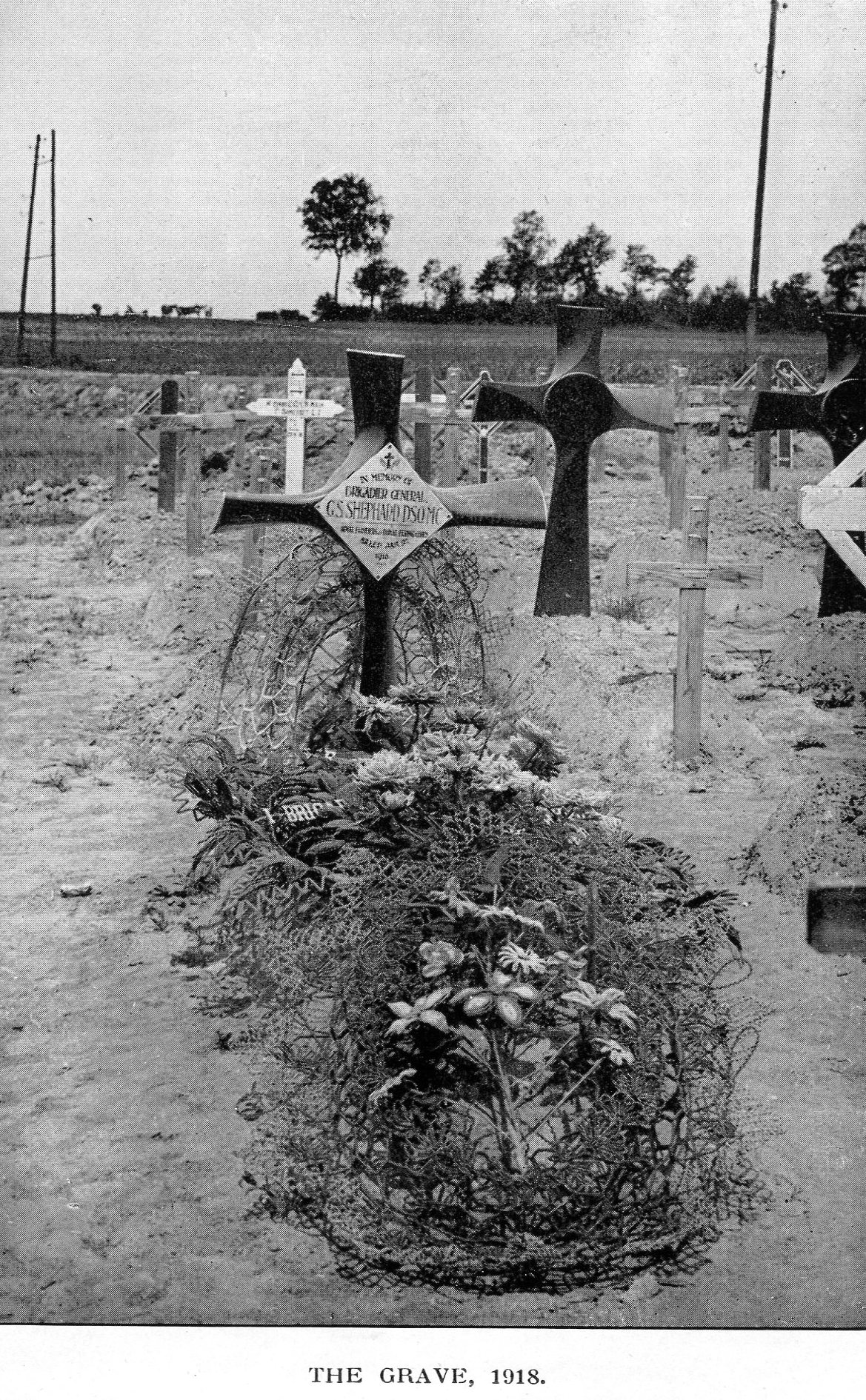
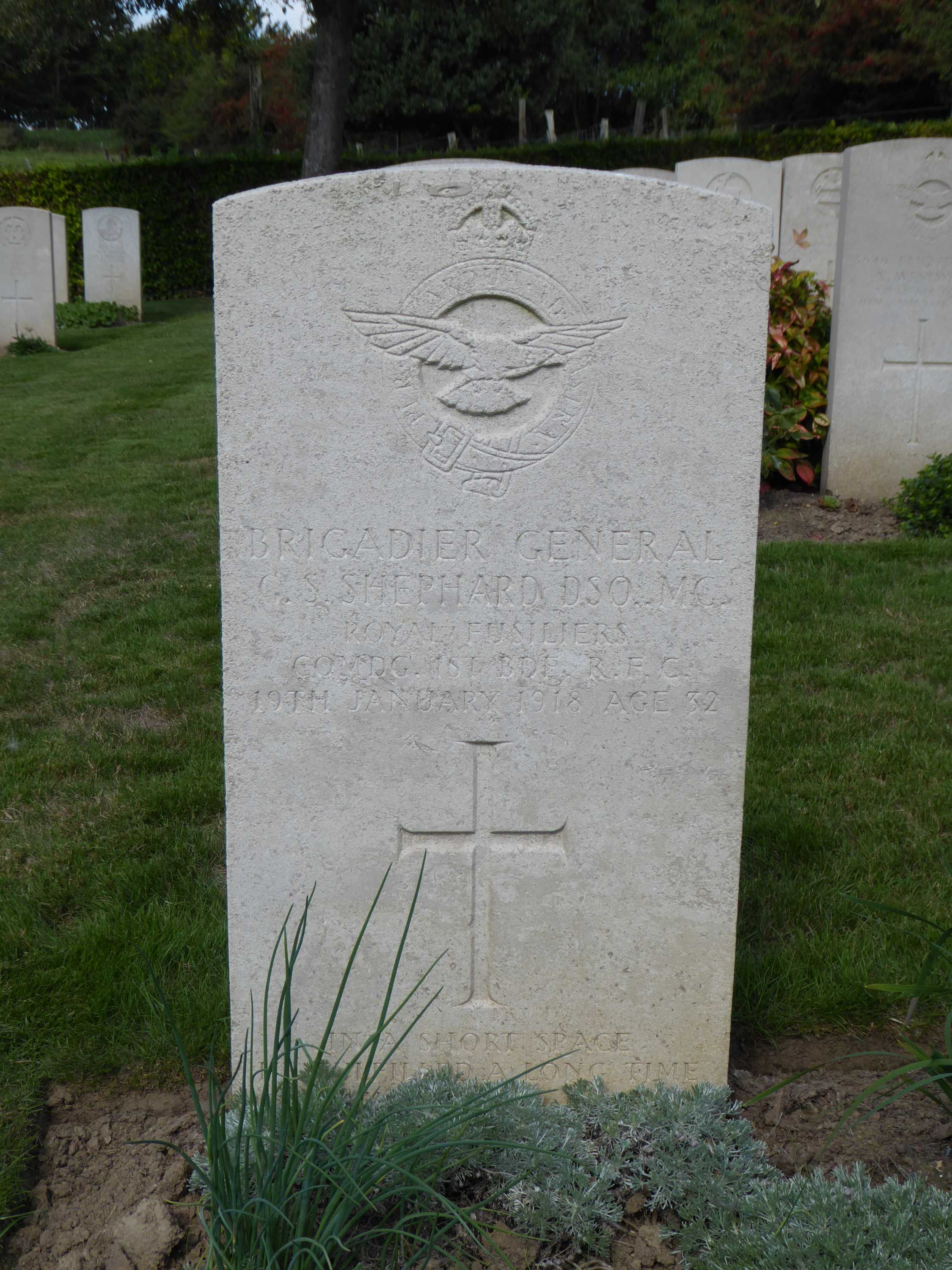 The grave at La Pugnoy today
The grave at La Pugnoy today
"In a short space, he fulfilled a long time, Wisdom IV.14, RIP"
Footnotes
- His CWGC entry reads:
MC, DSO, mentioned in despatches. Chevalier of the Legion of Honor (France). Royal Fusiliers, attd staff, Commanding 1st Bde Royal Flying Corps, 19th January 1918. Son of Sir Horatio and Lady Shephard, of 58 Montagu Square, London W.
- His file at the RAF Museum’s archives contained nothing on his Irish adventures, until the Spring-Rice account of the Asgard voyage was sent to them by the author, and gratefully received by the Museum.
- The Leslie family still own Castle Leslie today. It is run as an upmarket hotel.
- Memoirs of Gordon Shephard, ed. Shane Leslie, London 1924, p36.
- Ditto, p39.
- The Howth Gun Running, FX Martin, Dublin 1964, p126.
- Memoirs p69
- Memoirs p80
- Many of the geographical names in Memoirs have changed. Kronstadt has not, but St Petersburg became Leningrad and then back again. Christiana is now Oslo, Helsingfors is Helsinki, Reval is Tallinn, and Windau is Ventspils.
- Kronstadt was built to protect the city St Petersburg and the remains of the base still exist today.
- In fact, there had been a court case in Germany in the previous year where two British officers, Lieutenant Brandon RN and Captain Trench RM were imprisoned for spying, which is indeed what they were doing. So, the German authorities were somewhat jittery in the Shephard case.
- The Life and Death of Erskine Childers, Leonard Piper, Hambledon and London, London, 2003, p106.
- Diary of the gun-running voyage by Mary Ellen Spring-Rice, National Library of Ireland. She died on 1st December 1924 in Llan Gwyfan tuberculosis sanatorium near Ruthin in North Wales, so the diary was written some time before that date. The buildings are still a hospital. She is buried on her family’s former estate at Foynes, County Limerick.
- The RFC only started to do artillery spotting in late September 1914 whereas the Germans had been using aircraft for that purpose from the beginning of the war. See Years of Combat, Sholto Douglas, Collins, London, 1963.
- Memoirs p205 onwards.
- Francis Sheehy-Skeffington was a pacifist who was arbitrarily arrested and shot by the British army without trial during the Easter Rising.
- Professor Eoin MacNeill was the leader of Sinn Fein, which took no part in the Easter Rising, nor did he.
- Lapugnoy CWGC cemetery lies 6km west of Bethune and is not easy to find in the village as it is down a track between some houses. The cemetery also contains an RAMC lieutenant aged 42 who was an Irish Presbyterian church’s medical missionary to Western India, Neil Murphy Gavin. There is a YMCA volunteer there as well – Charles William Bowick, aged 18. The author has visited the cemetery on two occasions.
- Memoirs p221.
- Years of Combat, Sholto Douglas, Collins, London, 1963.
- Memoirs p226.
- Years of Combat, p69 onwards.
Additional references and acknowledgement
The Zeal of the Convert, the Life of Erskine Childers, Burke Wilkinson, Second Chance Press, Sag Harbour, New York, 1976.
A Thirst for the Sea. The sailing Adventures of Erskine Childers, Hugh and Robin Popham, Stanford Maritime, London, 1979.
The Howth Gun-running and the Kilcoole Gun-running, FX Martin, Merrion, Dublin, 2014.
The author is grateful to Stuart Haddaway, who is the RAF archivist, for information on Gordon Shephard from their records.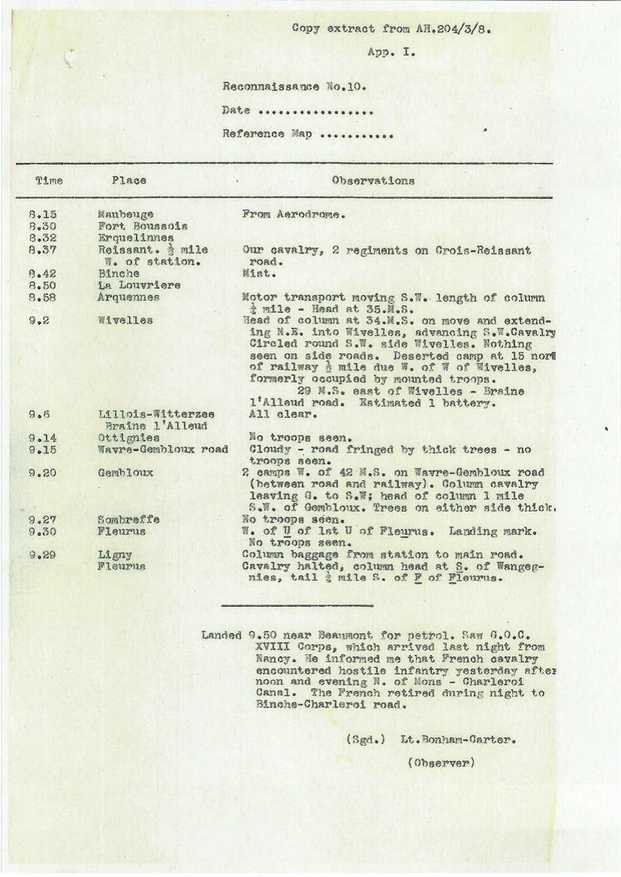
Report dated 22nd August 1914 from Shephard’s observer, Lt Bonham Carter